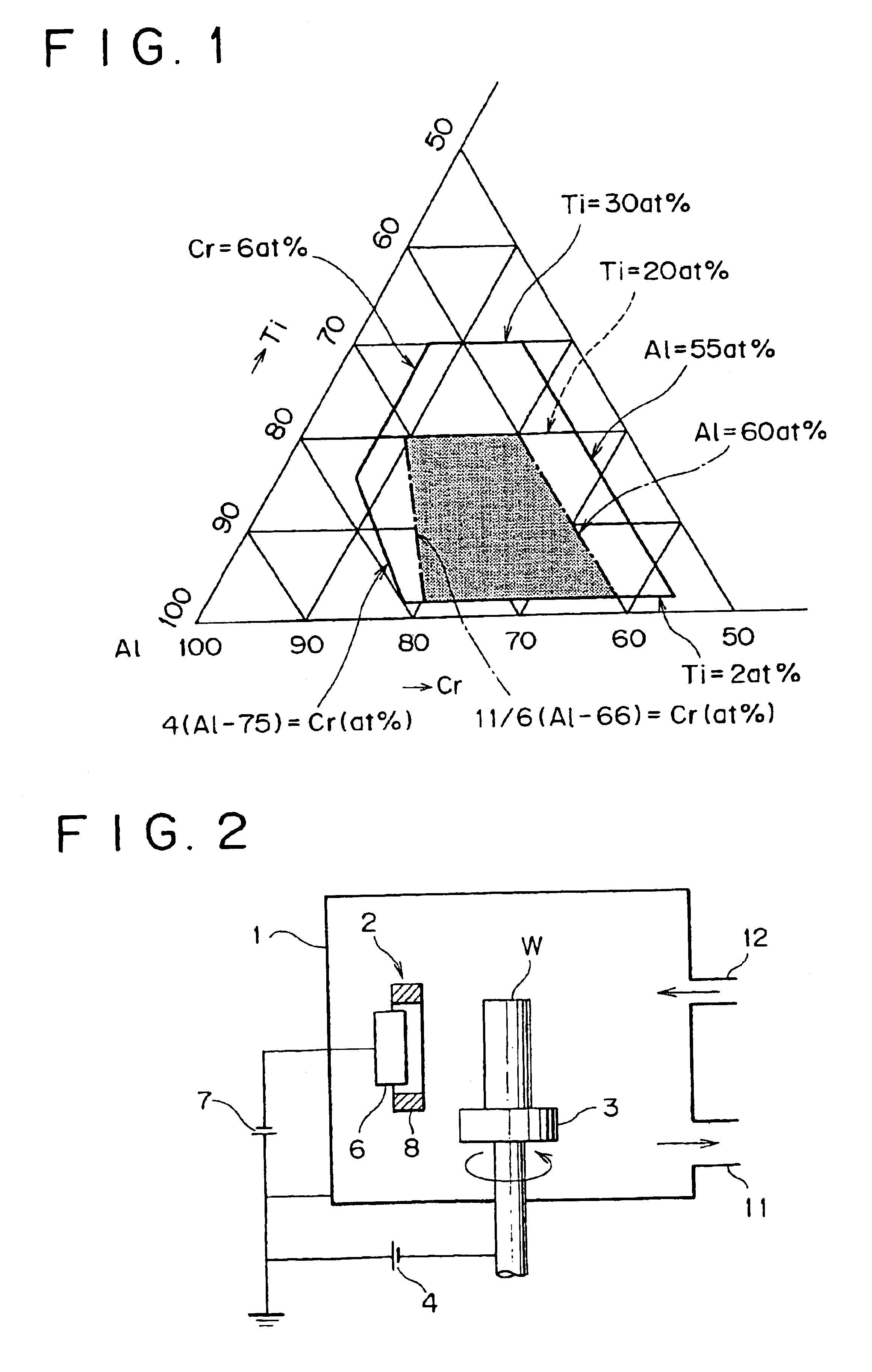Hard film for cutting tools, cutting tool coated with hard film, process for forming hard film, and target used to form hard film
a technology of hard film and cutting tool, applied in the field of hard film for cutting tool, cutting tool coated with hard film, process for forming hard film, target used to form hard film, can solve the problems of limited improvement in wear resistance, high hardness and good oxidation resistance of conventional tialn film, etc., and achieves poor sinterability, low relative density, and high hardness
- Summary
- Abstract
- Description
- Claims
- Application Information
AI Technical Summary
Benefits of technology
Problems solved by technology
Method used
Image
Examples
example 1
A target of alloy composed of Ti, Cr, and Al was mounted on the cathode of the AIP apparatus shown in FIG. 2. A substrate was mounted on the holder. The substrate is a chip of cemented carbide, a square end mill of cemented carbide (10 mm in diameter, with two edges), or a piece of platinum foil (0.1 mm thick). The chamber was evacuated to a degree of vacuum lower than 3.times.10.sup.-3 Pa while the substrate was being heated to 400.degree. C. by means of a heater placed in the chamber. The substrate was given a bias voltage of 700V in an argon atmosphere at 0.66 Pa, so that the substrate was cleaned with argon ions for 10 minutes. Subsequently, nitrogen gas was introduced into the chamber. With the chamber pressure kept at 2.66 Pa, an arc current of 100A was applied for film forming. A 4-.mu.m thick film was formed on the surface of the substrate. Incidentally, a bias voltage of 150V was applied to the substrate so that the substrate was kept negative with respect to earth potentia...
example 2
Samples Nos. 1, 4, 7, 11, 16, 18, 19, 22, 24, and 27 in Example 1, which are end mills coated with the hard film, were tested for wear resistance by cutting several works of quenched JIS-SKD61 (HRC50) under the following conditions.
Cutting speed: 200 m / min
Feed speed: 0.07 mm / edge
Depth of cut: 5 mm
Pick feed: 1 mm
Cutting oil: air blow only
Cutting direction: down cutting
After cutting over a length of 20 meters, the cutting edge of the end mill was examined under an optical microscope to measure the worn width. The results are shown in Table 2.
It is noted from Table 2 that the samples of end mills Nos. 1, 4, 7, 11 and 16, which are coated with the film meeting the requirements of the present invention, are superior in wear resistance (in terms of worn width) to the samples Nos. 18, 19, 22, 24, and 27, which are coated with the film not meeting the requirements of the present invention.
example 3
A target of alloy composed of Ti, Cr, Al, and Si was mounted on the cathode of the AIP apparatus shown in FIG. 2. A substrate was mounted on the holder. The substrate is a chip of cemented carbide, a square end mill of cemented carbide (10 mm in diameter, with four edges), or a piece of platinum foil (0.2 mm thick). The chamber was evacuated to a degree of vacuum lower than 3.times.10.sup.-3 Pa while the substrate was being heated to 550.degree. C. by means of a heater placed in the chamber. The substrate was cleaned with argon ions for 10 minutes. Subsequently, nitrogen gas or a mixture gas of nitrogen and methane was introduced into the chamber. With the chamber pressure kept at 2.66 Pa, an arc current of 100A was applied for film forming. An approximately 3-.mu.m thick film was formed on the surface of the substrate. Incidentally, a bias voltage of 100-200V was applied to the substrate so that the substrate was kept negative with respect to earth potential during film forming.
Aft...
PUM
| Property | Measurement | Unit |
|---|---|---|
| bias voltage | aaaaa | aaaaa |
| temperature | aaaaa | aaaaa |
| total pressure | aaaaa | aaaaa |
Abstract
Description
Claims
Application Information
 Login to View More
Login to View More - R&D
- Intellectual Property
- Life Sciences
- Materials
- Tech Scout
- Unparalleled Data Quality
- Higher Quality Content
- 60% Fewer Hallucinations
Browse by: Latest US Patents, China's latest patents, Technical Efficacy Thesaurus, Application Domain, Technology Topic, Popular Technical Reports.
© 2025 PatSnap. All rights reserved.Legal|Privacy policy|Modern Slavery Act Transparency Statement|Sitemap|About US| Contact US: help@patsnap.com



